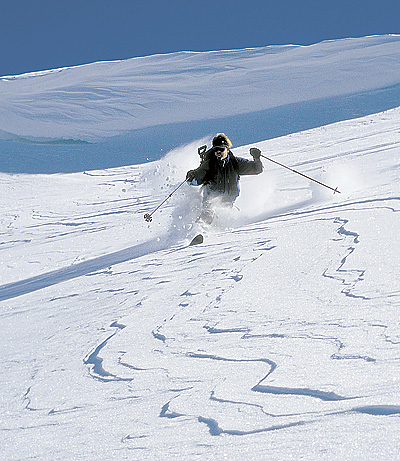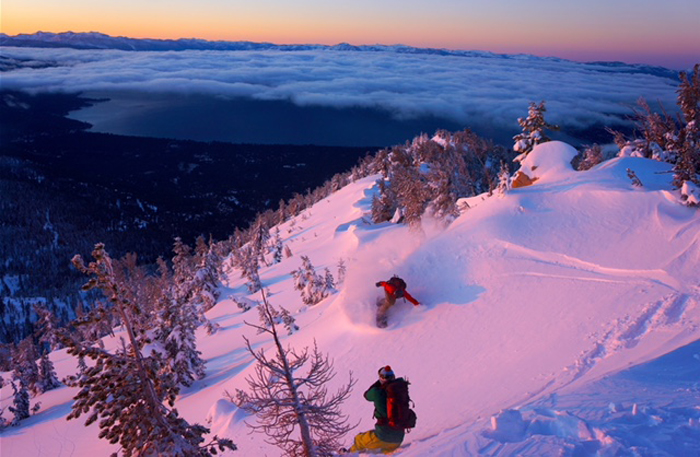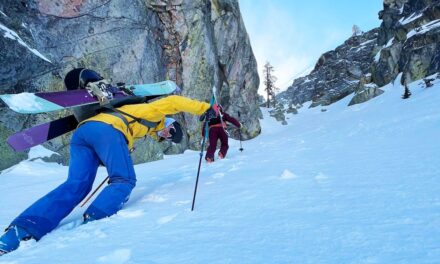- Tahoe’s Nevada Beach Tops the List of Hard-to-Book Campgrounds - 07/17/2024
- Cannabis Watershed Protection Program Cleans Up Illegal Grow Sites - 07/10/2024
- French Fire - 07/05/2024

Q&A with Craig Dostie, backcountry evangelist 20 years after founding Couloir magazine, Sierra-based scribe still earning his turns on peaks and in print
Craig Dostie started Couloir magazine 20 years ago (then “Le Chronicle du Couloir”), when backcountry skiing was very much a fledgling, little-known sport, and he did so out of a very unlikely birthplace, the LA suburb of Moorpark. It grew to become the country’s leading backcountry ski magazine and helped promote backcountry skiing and snowboarding during a period of tremendous growth that brought it into mainstream consciousness – relatively speaking, as it remains somewhat of a fringe sport, guarded by sweat and effort.
Moving the magazine north to Truckee in 1995, Couloir rose to become a true beacon and voice for the sport in North America and beyond, an authentic core ‘zine that celebrated mountains, famous and obscure, human-powered snow travel and the spirit, nobility, satisfaction and freedom that comes when you “earn your turns,” Couloir’s tagline and the enduring maxim Dostie coined. Perhaps no magazine was more eagerly anticipated among subscribers than a fresh issue of Couloir.
With Dostie at the helm throughout, and frequently sharing his expertise and opinions in articles and columns, the magazine’s circulation grew to 20,000 and spawned a sister publication, Telemark Skier. Last year, to the disappointment of many avid readers, Couloir was merged and folded into Backcountry magazine, a Vermont-based competitor, adopting the latter’s title. Dostie, a resident of Truckee, continues to play a significant role as a senior editor, particularly in the realms of gear reviews and avalanche science. While he admits that he works half as hard now, and he’s thankful for that, he misses the satisfaction of putting out his own magazine.
ASJ sat down with Dostie to talk about his two-decade run with Couloir, the evolution of the sport and what he envisions for the future, for both backcountry skiing and himself.
ASJ: Tell us what prompted you to start Couloir in 1988, its humble beginnings and SoCal roots?
The original newsletter was a consolation prize to a personal commitment I made back in ’88 to become published as a writer and/or photographer. Powder and Ski, and Skiing magazines had all rejected my photos and I realized if I was going to be published I had to do it myself. The Sierra Club group I skied with, the Alpine Ski Touring Committee, needed a newsletter to help attract more ski partners and allowed me to fulfill my personal commitment to being published.
After a few issues I asked folks to make donations to help with postage costs and they did. That blew me away. Suddenly I realized they were actually reading it, even liking it, and I began to dream. Heck, if there was that kind of interest in Southern California, then maybe there could be enough to sustain a magazine at the national level. Indeed there was.
ASJ: What are a few of the more notable memories and developments from Couloir’s 19 years of publication?
The most notable would have to be the friendships that began and remain with folks like Lou Dawson, Peter Kray, Brian Litz, Russell Rainey, various advertisers, vendors, and customers. Then there are the oddball memories, like being in the very convention booth that David Harrower, the founding publisher of Backcountry, chose to make his first ad pitch to. I’m sure if he had know I was under the table of Clair Yost’s booth stashing copies of Couloir he would have started making his pitch somewhere else. Or the first time I pitched advertising to potential advertisers myself and most of ‘em laughed in my face. John Cooley of Marmot didn’t, and his vote of confidence was a critical turning point.
It’s hard to say what the most important developments were. Certainly Couloir’s very presence helped focus attention on backcountry skiing. Internally I thought our first issue on a printing press was a big step (1990), then the first color cover (1993), our first all-color issue (1997), the first backcountry website (1996), and the first magazine devoted to telemark skiing (2002) were all important. Those things actually paled compared to functional issues like figuring out how to correct color, designing a custom logo, getting “high speed” internet access (128 kb), how to do on a PC what everyone else did on Macs, adapting to email, and learning all the inside minutia that allowed us to create a mag that looked as slick as the best, but remain rooted in the soul of the sport thanks to boot-strap financing and desktop wizardry.
With very few exceptions, everyone who worked at Couloir gave 100% and that was a very important element to the caliber of product that it became. One person, Susie Sutphin, deserves special mention. She was a person that I judged completely wrong on first impression, and thought was a ditzy blonde. Then I sat down and read her cover letter asking to work at Couloir and figured I’d give her a second chance. Much of the success of Couloir is due to Susie coming in and funneling all her boundless energy into growing Couloir. Intially, she came in with all these ideas and I had to point out that unless she could find new advertisers to fund those ideas, they would never happen. Shazam, she got it, and we grew. Telemark Skier was largely her idea.
ASJ: How did being based in California shape and influence your perspective of the sport, if at all?
The biggest part of backcountry skiing in California is that there are very few limits except in draught years. The Sierra is big enough to provide ski mountaineers with a playground that is both serious and benevolent. Serious because of the number of extreme routes possible, and benevolent because of the relatively stable snowpack and sunny disposition of the weather.
That combination was directly tied to the choice of Couloir as the title. In Colorado couloirs are skied with caution. By comparison, we were attacking couloirs with reckless abandon. It was this enthusiasm for pushing personal limits that motivated me to focus on portraying backcountry skiing from the steep perspective, and thus the name.
ASJ: What in your mind are the most significant developments in the sport over the last 20 years?
Two things.
Plastic telemark boots rank as the most important development for the growth of the sport. This was key because at the time they were developed, telemark was the dominant flavor of backcountry skiing in America. Unfortunately we all knew that it was too hard to learn to be able to grow the sport much, and with leather boots there were significant limits to what the average telemarker could ski in the downhill realm. Plastic telemark boots changed all that. Besides making it easier to learn, they allowed downhill performance on par with alpine skiers, which really fueled interest and growth.
Second, long term I always knew that for the sport to really grow Alpine Touring (AT) would have to catch fire, which occurred with the development of the Fritschi Freeride binding. AT bindings were plenty good up until then, but alpine skiers were reluctant to believe that AT bindings of the day (the Fritschi Diamir, Dynafit TLT, or Silvretta 500) could do the job. The Freeride erased most of their concerns and allowed backcountry skiing to attain the critical mass numbers it now has. Marker’s Duke, released a couple seasons ago, erased any lingering doubts about downhill performance and now everyone knows the only limit is whether or not you’re willing to earn your turns.
ASJ: You’re a die-hard telemarker, yet Couloir really helped push the growth of AT (alpine touring) gear and snowboards as equally good means of earning your turns, thus helping open up the backcountry to a much wider audience, a trend that has continued to this day. Tell us about the dynamics of this and how it might have changed the sport?
The choice to be inclusive of all downhill disciplines in the pages of Couloir was quite natural. I started backcountry skiing on Ramer bindings and didn’t switch to telemark until the year Le Chronicle du Couloir started. Very early on partners came in all three flavors, so the idea of limiting the scope of what disciplines we covered was always rejected by me. Besides, the sport wasn’t big enough to exclude anyone. The whole point was to persuade people to experience the satisfaction that comes from earning turns, not from the style of the turn.
Given that perspective, I should point out that I always believed that the key to growing the sport was to promote AT skiing above all other disciplines. But when we started, telemark was the dominant backcountry persuasion, so we reflected that. If you look close at the editorial though you will see a constant, relentless proclamation that AT was superior.
It was, and still is for many reasons, the most important of which is that most snow sliders are alpine skiers and AT doesn’t require them to buy all new gear or learn a new technique. All you need to do to enjoy the backcountry if you know how to ski already is buy AT bindings and add a pair of climbing skins.
We preached that over and over. I was actually pretty surprised that it took over 15 years for that message to sink in.
The reality is, no one would believe until the gear reflected what the consumer expected. Silvretta and Ramer bindings, and especially Dynafit bindings, simply don’t inspire enough confidence to overcome the natural skepticism of alpine skiers when they consider going in the backcountry. But today’s heavyweight versions do.
It took a paradigm shift on the part of European manufacturers to even consider producing something like the Fritschi Freeride. They couldn’t understand why anyone would want a heavy backcountry binding. Then they realized that without meeting the American consumers expectation that weight meant security they couldn’t sell their bindings or even the concept of earning your turns.
Even though my preference is for telemark, I was continually amazed that the most difficult discipline of the three was promoted as the easiest. What a joke. It is, however, the most fulfilling. Making a tele turn in deep pow is about as sensual an experience as a skier can have. By comparison, parallel turns are mere abbreviations of what is possible.
ASJ: What’s your most memorable ski trip in and out of California?
Nothing has surpassed the fun I had cutting my teeth at Baldy Bowl in SmelLA County (Ed. Note: Dostie’s spelling). To balance that though, every trip with friends is a great trip, no matter where it is.
The memory of some trips is stronger than others, and it’s usually because they were mini survival epics, like the first time a dozen of us skied the north side of San Jacinto and had to bivvy, or joining Dave Braun for what was arguably the 3rd descent of the Giants Steps Couloir on Mt Williamson’s north wall and my flirtation with disaster was embarrassingly close, or my wake up call in The Dare in SoCal.
Outside of California my fave memories are all in the huts of British Columbia, either at Ruedi Beglinger’s Durrand Glacier Chalet, or Grania Devine’s Selkirk Lodge. There are lots of new huts that I need to visit and “review.”
ASJ: If you didn’t live and ski in the Sierra, where would you base yourself?
Where the federalies can’t find me, but my friends still can.
ASJ: Do you see the sport’s growth leveling off or picking up steam?
In the near term it will level off, mostly due to the economic squeeze everyone is feeling right now. But that same pinch in the pocketbook will fuel even more growth for the backcountry. The first turns I ever earned were because I couldn’t afford a lift ticket but I had to go skiing. So I hiked, got hooked, and the rest is history. Many others will take it up in the next two years because they need a ski fix but won’t be able to justify the cost of a lift ticket. Once they earn ‘em, they’ll be converts for life.
ASJ: Other than working with Backcountry magazine, what else are you doing now or is on the horizon?
Mostly catching up on some reading that I didn’t have time for before. I’ve become a voracious reader of political news, history, and biblical commentaries. We’re in deep do-do and need some radical shifts in our collective thinking. Much of the trouble we’re in could have been predicted from history, so I’m delving in to a lot of that. There are lots of similarities with our current situation and the rise of National Socialism in Germany in the ‘20s, or the chaos of the French Revolution, and a huge disparity with our own birth as a country.
Work-wise, I’m helping Bela and Mimi Vadasz with marketing for Alpine Skills International and penning some freelance words in places you might not expect. There are other things on the horizon, but I’m not there yet. One of the key things I enjoyed with Couloir was the ability to influence public opinion. I see lots of other arenas where change is important and I’m getting ready to focus my energy there, hopefully, to improve things beyond the little world of backcountry skiing.
ASJ: Is there anything else you’d like to add?
Yeah. Because of the mechanics of how Couloir came to be folded in to Backcountry I never really had the chance to thank readers for their support over the years. Couloir never could have happened without you, so your support was truly appreciated. Even when under deadline I found it hard to not take a call from a subscriber who had a question for the editor. My staff was usually annoyed but I always knew we wouldn’t be doing what we were if it wasn’t for subscriber support.













